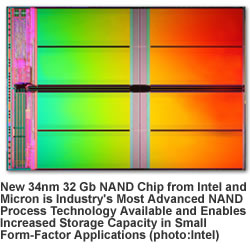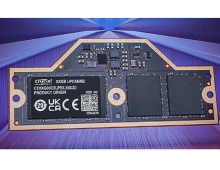
Intel and Micron to Deliver Sub-40 Nanometer NAND Flash Memory For SSDs
Today Intel and Micron introduced the industry's first sub-40 nanometer (nm) NAND memory device, unveiling a 34nm 32 gigabit (Gb) multi-level cell chip.
This process technology was jointly developed by Intel and Micron and manufactured by the companies' NAND flash joint venture, IM Flash Technologies (IMFT). It is the smallest NAND process geometry on the market. The 32 Gb NAND chip is the only monolithic device at this density that fits into a standard 48-lead thin small-outline package (TSOP), providing a cost-effective path to higher densities in existing applications. Shipments of samples begin in June and mass production is expected during the second half of this year calendar.
"The introduction of 34nm process technology highlights IMFT's rapid progress and moves us to the forefront of NAND process technology," said Pete Hazen, director of marketing, Intel NAND Products Group. "These advancements will expand the value proposition and accelerate the adoption of solid-state drive (SSD) solutions in computing platforms."
 The 34nm 32 Gb chips will be manufactured on 300 millimeter wafers, each producing approximately 1.6 terabytes of NAND. Measuring just 172mm2, less than the size of a thumbnail, the 34nm 32 Gb chip will cost-effectively enable high-density solid-state storage in small form factor applications.
The 34nm 32 Gb chips will be manufactured on 300 millimeter wafers, each producing approximately 1.6 terabytes of NAND. Measuring just 172mm2, less than the size of a thumbnail, the 34nm 32 Gb chip will cost-effectively enable high-density solid-state storage in small form factor applications.
A single 32 Gb chip could store more than 2,000 high-resolution digital photos or hold up to 1,000 songs on a personal music player.
Two 8-die stacked packages would realize 64 gigabytes (GBs) of storage, enough for recording anywhere from eight to 40 hours of high-definition video in a digital camcorder.
The 34nm 32Gb chip was designed with solid-state drives in mind. The product will enable more cost-effective SSDs, instantly doubling the current storage volume of these devices and driving capacities to beyond 256 GBs in today's standard, smaller 1.8-inch form factor.
Based on the 34nm architecture, Intel and Micron also plan to introduce lower density multi-level cell products including single-level cell products, by the end of this year.
"The introduction of 34nm process technology highlights IMFT's rapid progress and moves us to the forefront of NAND process technology," said Pete Hazen, director of marketing, Intel NAND Products Group. "These advancements will expand the value proposition and accelerate the adoption of solid-state drive (SSD) solutions in computing platforms."
 The 34nm 32 Gb chips will be manufactured on 300 millimeter wafers, each producing approximately 1.6 terabytes of NAND. Measuring just 172mm2, less than the size of a thumbnail, the 34nm 32 Gb chip will cost-effectively enable high-density solid-state storage in small form factor applications.
The 34nm 32 Gb chips will be manufactured on 300 millimeter wafers, each producing approximately 1.6 terabytes of NAND. Measuring just 172mm2, less than the size of a thumbnail, the 34nm 32 Gb chip will cost-effectively enable high-density solid-state storage in small form factor applications.
A single 32 Gb chip could store more than 2,000 high-resolution digital photos or hold up to 1,000 songs on a personal music player.
Two 8-die stacked packages would realize 64 gigabytes (GBs) of storage, enough for recording anywhere from eight to 40 hours of high-definition video in a digital camcorder.
The 34nm 32Gb chip was designed with solid-state drives in mind. The product will enable more cost-effective SSDs, instantly doubling the current storage volume of these devices and driving capacities to beyond 256 GBs in today's standard, smaller 1.8-inch form factor.
Based on the 34nm architecture, Intel and Micron also plan to introduce lower density multi-level cell products including single-level cell products, by the end of this year.





















